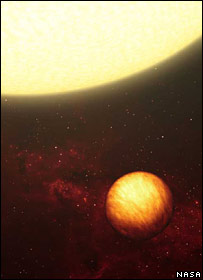The Spitzer Space Telescope provided the weather forecast photograph from an extrasolar planet. The planet known as Upsilon Andromeda b

The Spitzer Space Telescope provided the weather forecast photograph from an extrasolar planet. The planet known as Upsilon Andromeda B orbits a planet at a close distance 380 trillion km from Earth.
In fact, Spitzer was able to remotely measure the day and night temperature of the distant planet. The result, reported in the journal Science, shows that the weather system transfers very little heat from one side of the planet to the other. This means that one side of the planet is very hot, while the other side is frozen.
"Such differences between the day side and the night side reveal interesting things about the way heat and air masses flow on the planet. There is a rather strange climate and weather on the planet," says Dr. James Chu, one of the partners in the project, from Queen Mary University of London.
The resulting models are used by scientists to describe the weather systems on such planets and predict that there may be winds that redistribute the heat around the globe. However, Spitzer's measurements show that the atmospheric gases absorb the heat and immediately return it to the outside, says the project's lead researcher, Joe Harrington of the University of Central Florida in Orlando.
The findings represent the first attempt to find any variation across the orbit of an extrasolar planet. Previous measurements were only able to find global properties such as diameter and mass.
Opsilon Andromeda B was discovered in 1996 around the star Opsilon Andromeda. It is known as the prototype of the "hot Jupiter" type, because it is made of gas like Jupiter but is hot because it is in a tight orbit around the star, so that its year is only 4.6 days long - in fact, the orbit of the giant planet is as close to its sun as about one-sixth the distance of a Mercury star from the sun our. Since the discovery of the first planet in 1995, more than 200 such objects have been discovered.
